Partner
Joe LeSueur, Larry Rivers
Queer Places:
St John's High School, 378 Main St, Shrewsbury, MA 01545
New England Conservatory of Music, 290 Huntington Ave, Boston, MA 02115
Harvard University (Ivy League), 2 Kirkland St, Cambridge, MA 02138
University of Michigan, Ann Arbor, MI
326 E 49th St, New York, NY 10017
441 E 9th St, New York, NY 10009
San Remo Café, 93 Macdougal St, New York, NY 10012
Green River Cemetery, 787 Accabonac Rd, East Hampton, NY 11937
 Francis Russell "Frank" O'Hara (March 27, 1926 – July 25, 1966) was an
American writer, poet and art critic. Because of his employment as a curator
at the Museum of Modern Art, O'Hara became prominent in New York City's art
world. O'Hara is regarded as a leading figure in the New York School—an
informal group of artists, writers and musicians who drew inspiration from
jazz, surrealism, abstract expressionism, action painting and contemporary
avant-garde art movements. "You are ruining American poetry, O'Hara," a
bellicose Jack Kerouac once shouted at him
at a reading. O'Hara instantly and witheringly returned fire: "That's more
than you ever did for it, Kerouac."
Francis Russell "Frank" O'Hara (March 27, 1926 – July 25, 1966) was an
American writer, poet and art critic. Because of his employment as a curator
at the Museum of Modern Art, O'Hara became prominent in New York City's art
world. O'Hara is regarded as a leading figure in the New York School—an
informal group of artists, writers and musicians who drew inspiration from
jazz, surrealism, abstract expressionism, action painting and contemporary
avant-garde art movements. "You are ruining American poetry, O'Hara," a
bellicose Jack Kerouac once shouted at him
at a reading. O'Hara instantly and witheringly returned fire: "That's more
than you ever did for it, Kerouac."
O'Hara had three major romantic relationships, including Larry Rivers, the
love of his life. It was a stormy and not entirely mutual relationship in
every dimension: at O'Hara's funeral Rivers, though he had slept often with
O'Hara, called him, not his lover, but his "best friend." Always somewhat on
the rebound from Rivers, O'Hara also had affairs with
Vincent Warren and
Bill Berkson. Warren, an handsome
but rather flighty Metropolitan Opera dancer, not O'Hara's usual type, became
O'Hara's love object and chief muse in his early thirties; the result a cycle
of no less than fifty poems. Warren, however, was only twenty; "the whole
tragedy about Frank and me... is that he loved me," Warren later admitted,
"and I didn't know how to love at that age. It scared me. He gave the poems to
me and I never could know what to say." Berkson, on the other hand, a Brown
output, also twenty-something (though O'Hara by then approaching forty), was
full of "patrician reserve, bohemian curiosity, intelligence and politeness
and brash rudeness", much more in O'Hara league. In Berkson's case the demon
was not age but sex; though the relationship was an intimate one, friend,
confidant, sounding board, collaborator, soul mate, it was not physical enough
for Berkson, who did not find O'Hara physically attractive, perhaps the
deciding factor in their breakup. It was "like being friends in the eight
grade," Berkson complained.

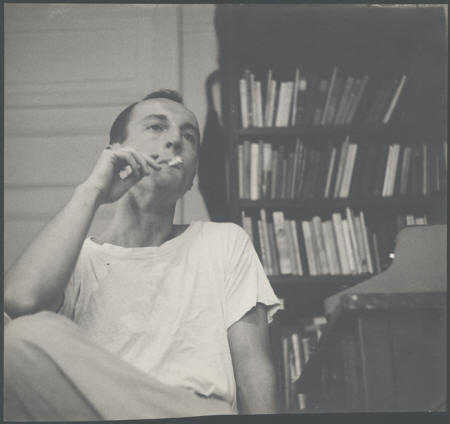

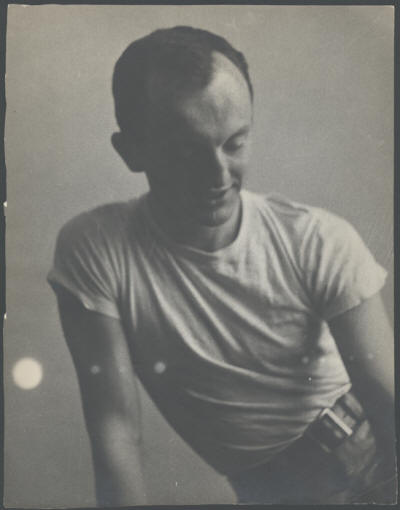
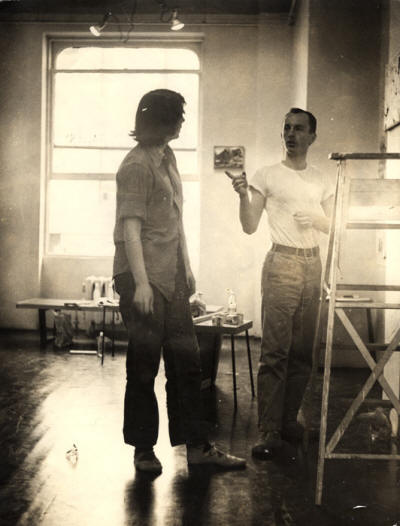
Grace Hartigan with Frank O'Hara
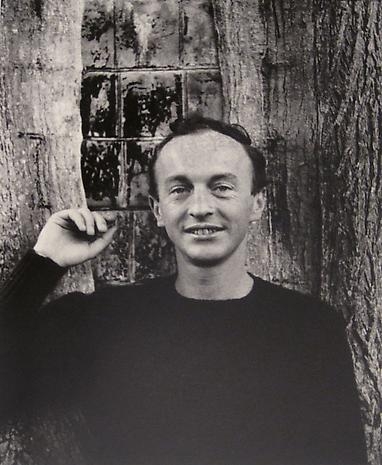
JOHN JONAS GRUEN
Frank O'Hara Smiles, Southampton, NY
1961
gelatin-silver print
13 x 10 inches

LARRY RIVERS and FRANK O'HARA
Portrait and Poem Painting
1961
oil on canvas
Private Collection

NELL BLAINE
Frank III
1952
India ink and traces of graphite on paper
12 x 9 inches
Private Collection

LARRY RIVERS
Frank O'Hara
c.1955
plaster
15 1/2 x 9 1/2 x 7 1/4 inches
Private Collection

GRACE HARTIGAN and FRANK O'HARA
Oranges no. 11
1952
oil on paper
44 1/2 x 35 inches
Marie-Helene and Guy Weill Family Collection

GRACE HARTIGAN and FRANK O'HARA
Oranges no. 5
1952
oil on paper
44 1/2 x 35 inches
Marie-Helene and Guy Weill Family Collection

LARRY RIVERS and FRANK O'HARA
Stones
1959
suite of thirteen lithographs
18 x 23 inches

JOE BRAINARD and FRANK O'HARA
I"m Not Really Flying, I'm Thinking
1964
collage and ink on paper
10 x 8 inches
Collection Bill Berkson and Connie Lewallen, San Francisco

JOE BRAINARD and FRANK O'HARA
I Grew This Mustache...
1964
collage and ink on paper
12 x 9 3/4 inches
Collection Bill Berkson and Connie Lewallen, San Francisco

Poets Dressed and Undressed, two panels portraying Joe Brainard, Frank O'Hara, Joe LeSueur and Frank Lima,
by Wynn Chamberlain
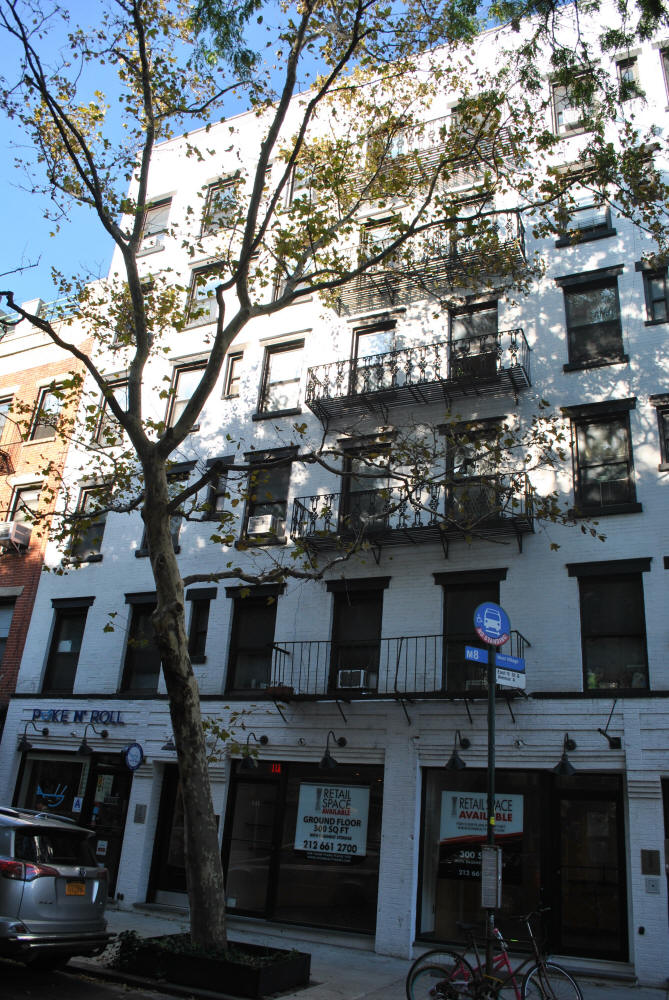
441 E 9th St
O'Hara's poetry is personal in tone and in content and has been described
as sounding "like entries in a diary".[1]
Poet and critic Mark Doty has
said O'Hara's poetry is "urbane, ironic, sometimes genuinely celebratory and
often wildly funny" containing "material and associations alien to academic
verse" such as "the camp icons of movie stars of the twenties and thirties,
the daily landscape of social activity in Manhattan, jazz music, telephone
calls from friends".[2]
O'Hara's writing sought to capture in his poetry the immediacy of life,
feeling that poetry should be "between two persons instead of two pages."[1]
The Collected Poems of Frank O'Hara edited by Donald Allen (Knopf,
1971), the first of several posthumous collections, shared the 1972 National
Book Award for Poetry.[3]
Frank O'Hara, the son of Russell Joseph O'Hara and Katherine (née
Broderick), was born on March 27, 1926,[4]
at Maryland General Hospital, Baltimore and grew up in Grafton, Massachusetts.
He attended St. John's High School. He grew up believing he had been born in
June, but in fact had been born in March, his parents having disguised his
true date of birth because he was conceived out of wedlock.[5]
O'Hara first sexual experience was with a stable boy in a barn on his family's
farm.
He studied piano at the New England Conservatory in Boston from 1941 to 1944
and served in the South Pacific and Japan as a sonarman on the destroyer USS
Nicholas during World War II.
With the funding made available to veterans he attended Harvard University,
where artist and writer Edward Gorey was his roommate. O'Hara was heavily
influenced by visual art and by contemporary music, which was his first love
(he remained a fine piano player all his life and would often shock new
partners by suddenly playing swathes of Rachmaninoff when visiting them). His
favorite poets were Pierre Reverdy,[6]
Arthur Rimbaud, Stéphane Mallarmé, Boris
Pasternak, and Vladimir Mayakovsky. While at Harvard, O'Hara met
John Ashbery and began
publishing poems in the Harvard Advocate. Despite his love of music,
O'Hara changed his major and graduated from Harvard in 1950 with a degree in
English. Once at Harvard, the 20 years old O'Hara kept the private screen
around himself and though many began to sense he was different, no one called
him out during his freshman or sophomore year. His Grafton friends came to
realize that O'Hara had no sexual interest in girls, but the subject remained
unmentioned. The O'Hara began to reveal himself under the friendship of
Edward Gorey, who would later gain
fame as a macabre illustrator. Another freshman veteran, Gorey was tall and
dressed flamboyantly in black. Becoming roommates, they decorated their Eliot
House suite with lawn furniture and a tombstone used as a table. Gorey often
fell asleep in the living room after all-nighters spent designing wall paper
and drawing ghoulish Edwardian cartoons using India ink. Some of O'Hara's
music department friends thought that Gorey had corrupted him. O'Hara and
Gorey were not lovers but they consciously adopted the highly stylized manners
of an Oscar Wilde-era couple.
In his senior year O'Hara moved away from Gorey and was finally able to
come out. He had several discrete liasons with other students and began to
enjoy seducing men. That year, O'Hara had a relationship with a non-veteran
student from the class of 1950,
Lawrence Osgood. A native of Buffalo, Osgood had dropped out for a year
for psychoanalysis in Philadelphia and then continued to see a therapist to
deal with his homosexuality. After a night of drinking that ended with them
back in O'Hara room with a bottle of Southern Comfort, O'Hara and Osgood were
dancing to Marlene Dietrich
records when O'Hara decided he wanted Osgood. I was Osgood's first time with a
man and O'Hara kept asking him if he was okay. Osgood saw the evening as the
beginning of a relationship, while O'Hara just wanted a one night stand.
In the early 1950s, Edward Gorey, with a group of recent Harvard alumni including
Alison Lurie (1947),
John Ashbery (1949),
Donald Hall (1951) and
Frank O'Hara (1950), amongst others, founded the Poets' Theatre in Cambridge, which was supported by Harvard faculty members
John Ciardi and
Thornton Wilder.[6][7][8]
He frequently stated that his formal art training was "negligible"; Gorey studied art for one semester at the School of the Art Institute of Chicago in 1943.[9]
O'Hara attended graduate school at the University of Michigan in Ann
Arbor. While at Michigan, he won a Hopwood Award and received his M.A. in
English literature in 1951. James Schuyler
met Frank O'Hara at a party in John Bernard Myers's 9th Street apartment after
a Larry Rivers opening at the Tibor de Nagy Gallery. O'Hara and Schuyler
shared an apartment at 326 E 49th Street, on and off, from 1952 until January 1957.
In 1951 Dwight Ripley
offered to back the Tibor de Nagy Gallery opened by John Bernard Myers as gallery
director. Dwight missed the excitement generated by
Peggy Guggenheim's art gallery,
closed in 1947 when she followed the last of the exiled Surrealist back to
Europe. In London, his Oxford contemporary
Peter Watson had helped found the
Institute of Contemporary Arts and was planning shows to feature the painters
Francis Bacon and
Lucian Freud. Encouraged,
probably goaded by this example, Dwight turned to his art-critic friend
Clement Greenberg for help. On the Monday evening of January 23, 1950, he took
aspiring art dealer John Bernard Myers to Greenberg's apartment in Greenwich
Village. "Ripley and John Myers," confirmed Greenberg's biographer 47 years
later, "came to Clem's apartment to consult with him about a noncommercial
gallery that Ripley would finance as silent backer and Myers would run."
Greenberg suggested the initial artists, Dwight wrote the first check, and the
result was Tibor de Nagy Gallery, which opened its doors that December and
rapidly became one of the influential art galleries in New York. In its first
full year Dwight provided the gallery with more than 5.000$, or five time its
annual rent. This was an historic contribution. Tibor de Nagy sponsored the
first solo shows of Larry Rivers, Grace Hartigan, Helen
Frankenthaler, Kenneth Noland, Fairfield
Porter, artists whose works would alter the conventions, then supreme, of
Abstract Expressionism. When the gallery's director John Myers published the
first chapbooks of poets John Ashbery,
Frank O'Hara, and Kenneth Koch, Dwight's
support altered the conventions of poetry as well.
Rupert Barneby owned a copy of
Frank O'Hara's Oranges, its cover individually painted by Grace Hartigan, who
in those days signed herself George. It was inscribed "to darling Dwight and
Rupert, oranges and kisses, George."
In December 1955 John Wieners worked on a
production of Finnegan's Wake at the Cambridge Poets' Theatre. There, Wieners
met Frank O'Hara while an understudy for O'Hara's
role in a play and the two bonded. They hung out at Cronin's on Dunster St,
and on the banks of the Charles. O'Hara was staying in an apartment over the
Wursthaus in Harvard Square at the time.
At the end of the 1950s O'Hara moved into an apartment in New
York City with
Joe LeSueur, who would be his roommate and sometime lover for the next 11
years.[7]
It was during this time that he began teaching at The New School.
Known throughout his life for his extreme sociability, passion, and warmth,
O'Hara had hundreds of friends and lovers throughout his life, many from the
New York art and poetry worlds. Soon after arriving in New York, he was
employed at the Museum of Modern Art, selling postcards at the admissions
desk, and began to write seriously.
O'Hara was active in the art world, working as a reviewer for Artnews,
and in 1960 was Assistant Curator of Painting and Sculpture Exhibitions for
the Museum of Modern Art. He was also a friend of the artists Norman Bluhm,
Mike Goldberg, Grace Hartigan, Willem de Kooning, Joan Mitchell and
Larry Rivers.
In the early morning hours of July 24, 1966, O'Hara was struck by a jeep on
the Fire Island beach, after the beach taxi in which he had been riding with a
group of friends broke down in the dark.[8][9][10][11]
He died the next day of a ruptured liver. Attempts to bring negligent homicide
charges against 23-year-old driver Kenneth L. Ruzicka were unsuccessful; many
of O'Hara's friends felt the local police had conducted a lax investigation to
protect one of their own locals.[12]
O'Hara was buried in Green River Cemetery on Long Island.[13]
The painter Larry Rivers,
a longtime friend and lover[14]
of O'Hara's, delivered one of the eulogies, along with Bill Berkson, Edwin
Denby and René d'Harnoncourt.[15]
My published books:


BACK TO HOME PAGE

- https://en.wikipedia.org/wiki/Frank_O%27Hara
-
Biographies - Syracuse University Libraries
- The Hub of the Gay Universe, An LGBTQ History of Boston, Provincetown,
and Beyond, by Russ Lopez, 2019
- Shand-Tucci, Douglass. The Crimson Letter . St. Martin's Publishing
Group. Edizione del Kindle.
 Francis Russell "Frank" O'Hara (March 27, 1926 – July 25, 1966) was an
American writer, poet and art critic. Because of his employment as a curator
at the Museum of Modern Art, O'Hara became prominent in New York City's art
world. O'Hara is regarded as a leading figure in the New York School—an
informal group of artists, writers and musicians who drew inspiration from
jazz, surrealism, abstract expressionism, action painting and contemporary
avant-garde art movements. "You are ruining American poetry, O'Hara," a
bellicose Jack Kerouac once shouted at him
at a reading. O'Hara instantly and witheringly returned fire: "That's more
than you ever did for it, Kerouac."
Francis Russell "Frank" O'Hara (March 27, 1926 – July 25, 1966) was an
American writer, poet and art critic. Because of his employment as a curator
at the Museum of Modern Art, O'Hara became prominent in New York City's art
world. O'Hara is regarded as a leading figure in the New York School—an
informal group of artists, writers and musicians who drew inspiration from
jazz, surrealism, abstract expressionism, action painting and contemporary
avant-garde art movements. "You are ruining American poetry, O'Hara," a
bellicose Jack Kerouac once shouted at him
at a reading. O'Hara instantly and witheringly returned fire: "That's more
than you ever did for it, Kerouac."
















